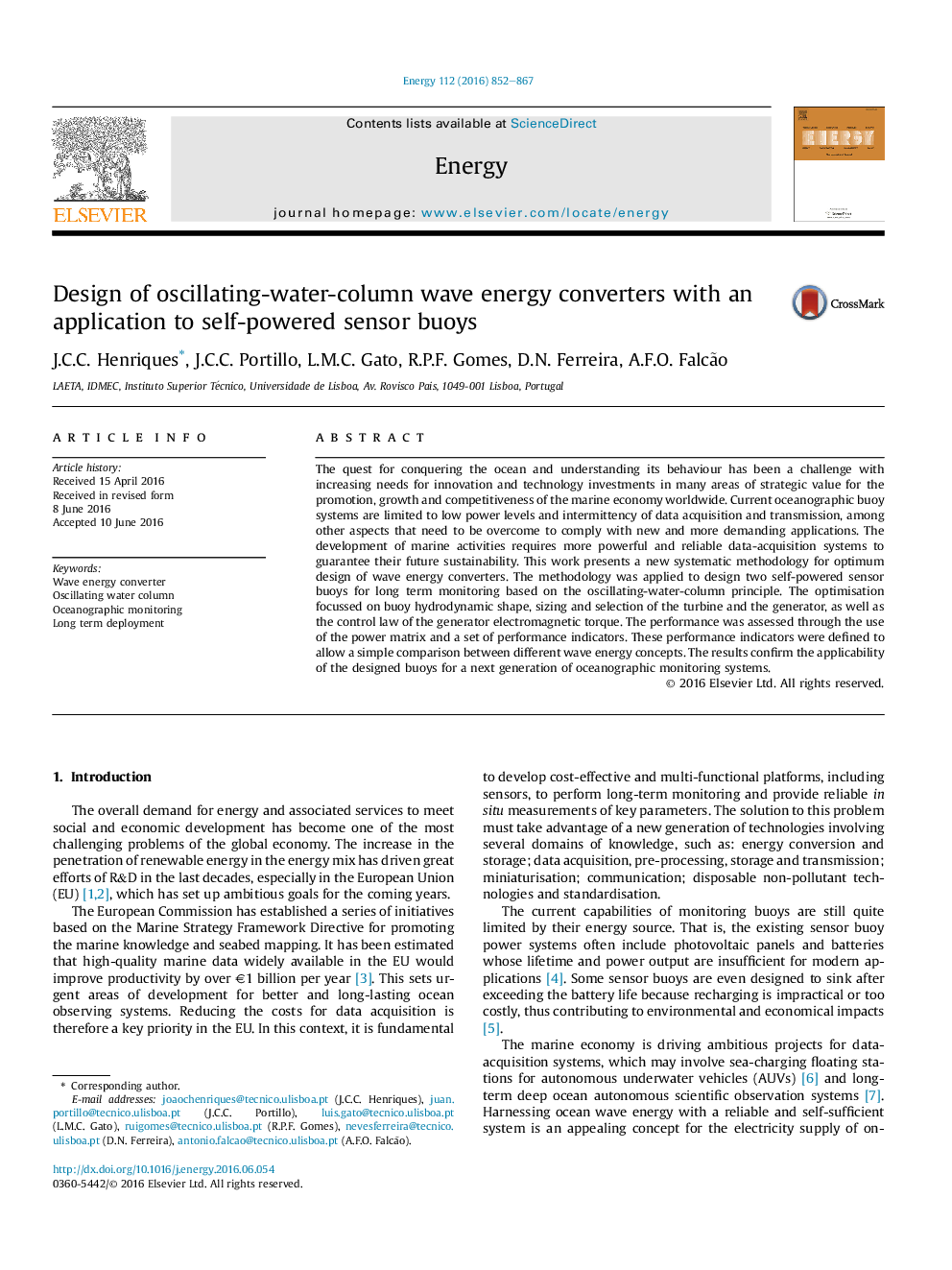| کد مقاله | کد نشریه | سال انتشار | مقاله انگلیسی | نسخه تمام متن |
|---|---|---|---|---|
| 8073114 | 1521436 | 2016 | 16 صفحه PDF | دانلود رایگان |
عنوان انگلیسی مقاله ISI
Design of oscillating-water-column wave energy converters with an application to self-powered sensor buoys
ترجمه فارسی عنوان
طراحی مبدل های موج انرژی ستون نوسان آب با استفاده از بوس های حسگر خودتنظیم
دانلود مقاله + سفارش ترجمه
دانلود مقاله ISI انگلیسی
رایگان برای ایرانیان
کلمات کلیدی
مبدل انرژی موج، نوسان ستون آب نظارت اقیانوس شناسی، بلند مدت استقرار،
ترجمه چکیده
تلاش برای فتح اقیانوس و درک رفتار آن، یک چالش با افزایش نیاز به سرمایه گذاری های نوآوری و فن آوری در بسیاری از زمینه های ارزش استراتژیک برای ارتقاء، رشد و رقابت اقتصاد دریایی در سراسر جهان است. سیستم های شناور اقیانوس شناختی فعلی محدود به سطح کم قدرت و متلاشی شدن از دست دادن و انتقال داده ها هستند، در میان جنبه های دیگر که باید برای تطبیق با برنامه های جدید و سخت تر مورد نیاز باشد. توسعه فعالیت های دریایی مستلزم سیستم های قدرتمند و قابل اطمینان بیشتری برای کسب اطمینان در مورد آینده خود است. این مقاله یک روش جدید سیستماتیک برای طراحی بهینه مبدل های انرژی موج ارائه می دهد. این روش برای طراحی دو بویه حسگر خودی برای نظارت طولانی مدت بر اساس اصل نوسان آب-ستون استفاده شد. بهینه سازی با توجه به شکل هیدرودینامیکی بوئینگ، اندازه گیری و انتخاب توربین و ژنراتور، و همچنین قانون کنترل گشتاور الکترومغناطیسی ژنراتور، متمرکز شده است. عملکرد با استفاده از ماتریس قدرت و مجموعه ای از شاخص های عملکرد ارزیابی شد. این شاخص های عملکردی به منظور مقایسه ی ساده ی مفاهیم انرژی موج مختلف تعریف شد. نتایج استفاده از شناورهای طراحی شده برای نسل بعدی سیستم های نظارت اقیانوس شناسی را تأیید می کند.
موضوعات مرتبط
مهندسی و علوم پایه
مهندسی انرژی
انرژی (عمومی)
چکیده انگلیسی
The quest for conquering the ocean and understanding its behaviour has been a challenge with increasing needs for innovation and technology investments in many areas of strategic value for the promotion, growth and competitiveness of the marine economy worldwide. Current oceanographic buoy systems are limited to low power levels and intermittency of data acquisition and transmission, among other aspects that need to be overcome to comply with new and more demanding applications. The development of marine activities requires more powerful and reliable data-acquisition systems to guarantee their future sustainability. This work presents a new systematic methodology for optimum design of wave energy converters. The methodology was applied to design two self-powered sensor buoys for long term monitoring based on the oscillating-water-column principle. The optimisation focussed on buoy hydrodynamic shape, sizing and selection of the turbine and the generator, as well as the control law of the generator electromagnetic torque. The performance was assessed through the use of the power matrix and a set of performance indicators. These performance indicators were defined to allow a simple comparison between different wave energy concepts. The results confirm the applicability of the designed buoys for a next generation of oceanographic monitoring systems.
ناشر
Database: Elsevier - ScienceDirect (ساینس دایرکت)
Journal: Energy - Volume 112, 1 October 2016, Pages 852-867
Journal: Energy - Volume 112, 1 October 2016, Pages 852-867
نویسندگان
J.C.C. Henriques, J.C.C. Portillo, L.M.C. Gato, R.P.F. Gomes, D.N. Ferreira, A.F.O. Falcão,
